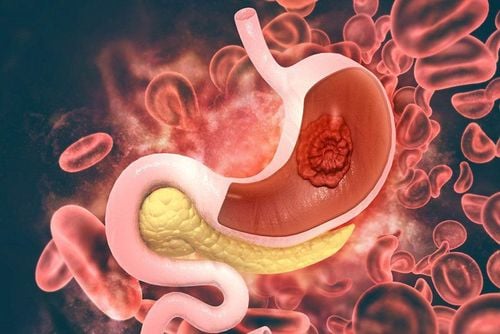This is an automatically translated article.
Stomach cancer is the most common cancer, accounting for about 10% of all cancers in general and 60-70% of all gastrointestinal cancers. In Vietnam every year, a large number of new patients with gastric cancer are recorded, accounting for a high percentage of these patients who are late hospitalized at the metastatic stage. So how often does stomach cancer metastasize?
1. What is stomach cancer?
Stomach cancer comes from the abnormal growth of cells in the stomach in an uncontrolled way, creating a malignant tumor. Gastric tumors not only grow locally but also have the ability to invade nearby organs, at a later stage gastric cancer can metastasize to regional lymph nodes or distant organs. other organs throughout the body.
Stomach cancer is common in people over 50 years old, but the disease tends to be younger and can be seen in younger patients. Men get stomach cancer twice as often as women.
Stomach cancer may be related to a previous stomach infection with Helicobacter pylori (HP) bacteria. Helicobacter pylori can destroy the stomach lining causing stomach ulcers, and can develop into precancerous lesions later on. Precancerous lesions of the stomach may be associated with:
Structural changes of gastric mucosal cells and uncontrolled multiplication (dysplasia). Atrophic inflammation of the gastric mucosa. Morphological changes of gastric mucosal cells similar to those of intestinal cells (intestinal metaplasia). Genetics: People with a family history of stomach cancer have a higher risk of stomach cancer than the general population. Gastric surgery: People with a history of stomach-related surgery are also a risk factor for stomach cancer. stomach cancer. Stomach cancer in the early stages often has no signs or very vague symptoms, easy to miss or confuse with other diseases. According to the SEER Program of the US National Cancer Institute, in the period 2009 - 2015, among gastric cancer patients, 36% of patients were in the metastatic stage at the time of diagnosis. In Vietnam, this number is even higher because patients often arrive late to the hospital.
2. Mechanism of metastasis in gastric cancer
In the late stages, stomach cancer cells can travel far from the primary stomach tumor to other organs of the body, creating secondary lesions (metastasis). The mechanism of metastasis in gastric cancer can follow several different pathways:
2.1. Gastric cancer metastases by lymphatic route Gastric cancer cells can follow the lymphatic flow to the serosa, creating secondary lesions just below the serosa, or spreading metastases in the peritoneum. These cells can also reach regional lymph nodes, causing metastases, most often in the small curvature of the stomach or in the lymph nodes around the abdominal aorta. In the lymph node organization, cancer cells can be destroyed, can stay in the lymph node in a dormant state, or develop into a lymph node metastasis. Cancer cells can travel through the lymphatic system to more distant lymph nodes and possibly into the bloodstream. Gastric cancer lesions can invade into the thoracic duct leading to metastasis in the left subclavian lymph node. 2.2. Stomach cancer metastases by blood Stomach cancer cells can invade small blood vessels directly, or into veins indirectly through lymphatics, which is why cancer cells often It travels through the veins rather than the arteries, thereby following the blood flow to other organs in the body, creating distant metastatic lesions.
Hematogenous metastasis depends on the primary tumor with systemic venous involvement. For gastric cancer as well as gastrointestinal cancers, cancer cells will follow the portal vein to the liver, then from the liver through the inferior vena cava to the right heart, and then to the lungs causing lung metastases.
2.3. Gastric cancer metastasis through body cavities
The mechanism of ovarian metastasis in women with gastric cancer can be explained by the migration of malignant cells from the stomach to the ovary by clear fluid. in the peritoneal cavity, the metastatic ovarian lesion in this case was called a Krukenberg tumor. However, this metastasis has not been ruled out as lymphatic.
3. How often does stomach cancer metastasize?
A study in Sweden in the period 2002 - 2012 showed that 26% of gastric cancer cases metastasized to one site and 13% of cases metastasized to multiple sites. Liver metastasis is the most common in gastric cancer with the rate of 48%, followed by peritoneal metastasis with 32% of patients. Gastric cancer with lung metastases ranked third among these with 15% of patients. Bone metastases were also seen in 12% of patients with metastatic gastric cancer. Stomach cancer with brain metastases is less common.
3.1. Stomach cancer metastasis to abdominal lymph nodes Adjacent abdominal lymph nodes are often the first "destination" when stomach cancer enters the metastatic stage. The number and size of metastatic lymph nodes reflect the progression of gastric cancer. The lymph nodes commonly affected by gastric cancer include: paracardiac, pancreatic, splenic, left gastric, and superior and inferior pylorus. In particular, gastric cancer often metastasizes to the small curvature of the stomach and abdominal aortic nodes.
3.2. Gastric cancer metastasis to cervical lymph nodes As mentioned above, gastric malignancies can invade the thoracic duct causing metastases to the left subclavian or other cervical lymph nodes.
Metastatic cervical lymph nodes in cancer often have the following characteristics: large size, firmness, irregular margins, poor mobility, and can rupture causing ulcers and infections. Sometimes patients may have an itchy neck, choking when there is a cervical lymph node metastasis.
3.3. Gastric cancer liver metastasis The liver is anatomically close to the stomach, so stomach cancer is easy to invade or metastasize to the liver. One report showed that up to 48% of patients with liver metastatic gastric cancer among metastatic gastric cancers.
Patients with liver metastases stomach cancer may present with symptoms such as right upper quadrant abdominal pain, loss of appetite, jaundice, yellow eyes, nausea, palpable right upper quadrant.
3.4. Stomach cancer with peritoneal metastasis The peritoneum is the covering structure surrounding the abdominal organs and the perineum. Cancer cells can metastasize from the stomach to the peritoneum, causing severe symptoms, reduced survival, and increased mortality.
3.5. Although the lung is located far from the stomach, cancer cells after entering the liver can follow the bloodstream to the lungs, causing lung metastasis. As secondary lung lesions enlarge, respiratory symptoms such as cough, shortness of breath, and possibly respiratory failure occur.
3.6. Stomach cancer with bone metastasis The percentage of gastric cancer patients with bone metastasis is about 12%. Stomach cancer cells can follow the lymphatic route to spread to bone tissue, causing bone thickening, bone loss, bone pain, and even affecting the patient's movement.
3.7. Stomach cancer with brain metastases Stomach cancer with brain metastases is rare, however, gastric cancer patients with secondary brain lesions may present with serious conditions such as cerebral edema, which is life-threatening. to the patient's life.
Please dial HOTLINE for more information or register for an appointment HERE. Download MyVinmec app to make appointments faster and to manage your bookings easily.













